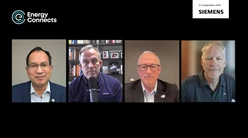European Gas Falls to Lowest in a Year Before Trump–Putin Talks
(Bloomberg) -- Europe’s natural gas prices slid to the lowest level in more than a year ahead of a historic summit between US President Donald Trump and Russia’s Vladimir Putin, which will seek to end a war that collapsed fuel flows from what was once the continent’s biggest supplier.
Gas futures traded in Amsterdam dropped to the lowest since last July, extending a more than 10% drop since the start of this month. While few traders foresee an imminent return of Russian pipeline gas to Europe — even if a ceasefire in Ukraine is agreed — any tightening or loosening of sanctions on Russian energy could have significant implications for global supplies.
European gas prices are still above the levels they typically traded at before the energy crisis that began more than three years ago when Russia invaded Ukraine. These days, the region gets most of its supplies from far-flung countries including the US and Qatar — with less than a fifth coming from Russia last year — but it competes for those cargoes with other major buyers in Asia.
A revival of Russian liquefied natural gas projects, some of which are under US sanctions, could add to the pool of global supplies and make attracting shipments easier.

“The extent of any energy-sanctions relief will hinge on the scale of a Putin-led ceasefire, a verifiable end to the war in Ukraine, and credible commitments to reconstruction in non-occupied Ukrainian territory,” said Claudio Steuer, a senior research fellow at the Oxford Institute for Energy Studies.
Ahead of the meeting, the Trump administration sought to temper expectations for a breakthrough. Trump sees the summit as a precursor to a second, more important gathering that could include Ukraine’s President Volodymyr Zelenskiy, and potentially some allied nations. Without a lasting peace, it’s hard to expect a tangible impact on energy supplies.
Still, BloombergNEF estimates that total Russian LNG supply could reach 50 million tons by 2030 if related sanctions are lifted, up 50% from 2024. Production facilities including the Arctic LNG 2 project and two smaller gas liquefaction plants currently face restrictions.
Meanwhile, the US president has warned Moscow that he’s ready to impose “very severe consequences” if Putin doesn’t agree to a ceasefire. Trump already doubled tariffs on India to 50% for its purchases of Russian oil.
In addition, he’s been pushing Europe to buy more LNG from the US, with several new projects expected to come online in the coming years. Europe has pledged to phase out Russian energy imports altogether by the end of 2027.
With gas prices having fallen in the run-up to the meeting, analysts at Energy Aspects Ltd. led by Erisa Pasko and James Waddell expect they may rebound as the market could be overestimating a quick return of Russian gas.
Higher prices could also come about if the US raises penalties on Russian oil and gas in the absence of progress on a deal. Fortunately for Europe, it has made steady progress on increasing storage injections so far this year, with reserves nearly 73% full.
“We are now used to expect the unexpected, both from Trump and Putin, and this explains why the market is having a hard time positioning itself,” said Jean-Christian Heintz, a former energy-trading executive who is now an independent consultant at Wideangle LNG.
Ahead of the meeting on Friday, Dutch front-month futures, Europe’s gas benchmark, traded lower at € by 3:35 p.m. in Amsterdam. There is unlikely to be any news from the talks, which start at 3 p.m. New York time, before gas trading closes at 6 p.m. in Amsterdam. That means potential price reactions won’t come until the market reopens Monday morning.
©2025 Bloomberg L.P.





